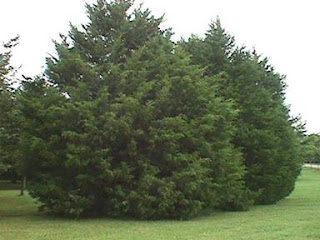Southern Red Cedar
Juniperus silicicola
Growing up in South Alabama, one of our family Christmas traditions was to dig up a Southern Red Cedar tree from the woods and use it as our Christmas tree. Starting at the beginning of deer season, my father would keep his eye open for the ‘perfect’ tree. Around the middle of December, we would go dig the tree up and ‘pot’ it to be decorated. Unfortunately, the branches aren’t as sturdy as the other tree species used as Christmas trees, and some of the ornaments drooped. I remember there were times I was embarrassed by our tree but now as I look back, it was very cool. The coolest thing was that after Christmas was over, we planted the tree in our yard. My mom still lives there and every time I visit I can see Christmas trees from my childhood.
The Southern Red Cedar is not actual cedar trees but in the Juniper family. Red cedars are frequently used as living screens. They grow fast and have very dense foliage with the lower branches often persisting to ground level. Closely spaced trees can form a visual barrier within just a couple years of setting out and rarely need any pruning. They are useful as windbreaks and shelterbelts. While South Florida is a south of the natural range for these trees, they do grow here and there are examples throughout Broward County. Pencil wood is usually made from red cedars and a thriving pencil manufacturing industry once populated the Gulf Coast of the southeastern U.S. where red cedars grew (and still do) in abundance. The industry was severely impacted by the invention of the ball-point pen. The red, aromatic wood (apparently not liked by clothes moths) is used for cedar chests and closets. The wood is resistant to rot and sometimes used for fence posts. Native Americans made bows from the wood. They also inhaled smoke from the cones, twigs, roots and wood for the treatment of colds and coughs. Juniper oil from the “berries” is used to flavor gin. Birds relish the mature female cones (called “juniper berries”) which persist into winter.
The Southern Red Cedar is a densely-foliated, wide pyramidal, columnar or oval evergreen grows fairly quickly, ultimately reaching heights up to 40 feet with a 25-foot spread. Some individual plants grow wider than tall as they grow older. Some botanists do not make a distinction between Juniperus silicicola and Juniperus virginiana (Eastern Red Cedar). Its fine-textured, medium green leaves and drooping branchlets help to soften the rather symmetrical, oval juvenile form. Mature specimens of Southern Red cedar take on a flat-topped, almost windswept appearance, making them very picturesque. Bark and trunk on older specimens take on a delightful, `old-tree' look.
Drought tolerance: high
Aerosol salt tolerance: high



